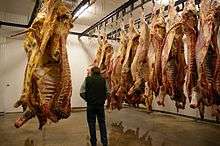Hanging (meat)

Meat hanging is a culinary process, used in beef aging, that improves the flavor of meats by allowing the natural enzymes in the meat to break down the tissue through dry aging. The process also allows the water in the meat to evaporate, thus concentrating the flavor.
History
Meat has been hung and dry aged throughout history after butchers discovered that this method makes beef more tender and flavorful than meat eaten immediately after slaughter and butchering.[1] In the 1960s, a combination of meat hanging’s expense and the new process of wet-aging caused meat hanging to almost stop entirely. Meat hanging experienced a surge of popularity in the 1980s though, and dry aged beef continues to be sold in high-end restaurants around the world.[2]
Process
The process of meat hanging involves hanging the meat (usually beef) in a controlled environment. The meat hanging room must be temperature controlled from between 33 and 37 degrees Fahrenheit (1-3 degrees Celsius). It is such a small window in temperature because the meat will spoil if the room is too hot and the process of dry aging stops if the water in the meat freezes. Furthermore, due to the water needing to slowly evaporate the room must be kept to a humidity of around 85%. Also, to prevent bacteria developing on the meat, the room must be kept well ventilated. The meat must be furthermore checked on in regular intervals to ensure that the meat does not spoil and the process is working correctly.[3]
Meat hanging allows processes to continue in the meat that would normally cease in dead animals. For example, the muscles in the meat continue to use the oxygen that is in the proteins of the blood. This normal biological process creates a chemical by-product known as lactic acid. Since the blood is no longer being circulated through the body, the lactic acid starts to break down the muscle and connective tissues around it.[1]
The process takes, at a minimum, eleven days. At this point, the meat will noticeably taste better. However, the longer the meat is hung, the better the flavor will be. This length of time also results in a greater chance that the meat will spoil. Therefore, most companies will only hang meat for 20–30 days.[3] Furthermore, dry aged meat will shrink, as much of the water has been evaporated. This loss of mass causes the meat to shrink 10-15% in size.[1]
Beef’s appearance changes through the dry aging process. The meat will change color from red to purple and will be much firmer than fresh meat.[1]
Popularity
Meat hanging has lost popularity due to its expense. Since the process requires a large room with specific environmental needs as well as constant attention, the price per pound of hung meat is substantial. Furthermore, the price of hung meat is compounded because of the high chance of the meat spoiling.[2] Therefore, wet-aged beef is more commonly seen in grocery stores, as dry aged beef is 15 to 25 per cent more expensive.[1]
See also
References
- 1 2 3 4 5 "Dry Aging Beef". GoodCooking. March 2009.
- 1 2 "What is Dry Aging?". Winn Meat Company. February 2011.
- 1 2 Riches, Derrick (February 2011). "Aging Beef – Dry Aging: The nearly lost art of the great Steak". About.com.

